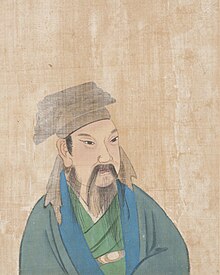
Back وانج سيجي Arabic Ван Січжы Byelorussian ཝང་ཞི་ཀྲི། Tibetan وانگ سیژی CKB Wang Si-č’ Czech Wang Xizhi German Wang Xizhi Spanish وانگ ژیچی Persian Wang Xizhi French Vòng Hî-chṳ̂ HAK
Wang Xizhi | |||||||||||||||||||||||||
|---|---|---|---|---|---|---|---|---|---|---|---|---|---|---|---|---|---|---|---|---|---|---|---|---|---|
王羲之 | |||||||||||||||||||||||||
 Depicted in Portraits of Famous Men, 19th – early 20th century | |||||||||||||||||||||||||
| Born | c. 303 | ||||||||||||||||||||||||
| Died | c. 361 (aged 58) | ||||||||||||||||||||||||
| Known for | Chinese calligraphy | ||||||||||||||||||||||||
| Notable work | Lantingji xu | ||||||||||||||||||||||||
| Family | Wang clan of Langya | ||||||||||||||||||||||||
| Chinese name | |||||||||||||||||||||||||
| Chinese | 王羲之 | ||||||||||||||||||||||||
| |||||||||||||||||||||||||
Wang Xizhi (Chinese: 王羲之; courtesy name: Yishao (逸少); c. 303 – c. 361) was a Chinese politician and writer from the Jin dynasty (266–420) known for his mastery of Chinese calligraphy. He is often regarded as the greatest calligrapher in Chinese history. His most famous work, composed in 353, is the Lantingji xu (蘭亭集序; "Preface to the Poems Composed at the Orchid Pavilion").
Born in Langya Commandery (in present-day Linyi, Shandong), Wang fled to southern China in his childhood after the collapse of the Western Jin dynasty. He studied calligraphy under the tutelage of relatives, including Wei Shuo, and became engaged to Xi Xuan around the year 323. They had eight children, including Wang Xianzhi, who later became a renowned calligrapher in his own right. Between 324 and 354, Wang Xizhi served in various government positions. He received his highest title, "General of the Right Army", in 347, and was appointed administrator of Kuaiji (present-day Shaoxing, Zhejiang). In 353, he hosted 41 of his friends, relatives, and pupils at the Orchid Pavilion Gathering on Mount Kuaiji. There, the participants took part in a "winding stream party" and Wang composed the Lantingji xu, a preface to the collection of poems that were written that day. He retired from governmental service in 355, devoted himself to Taoist practices, and died c. 361 in Jinting (present-day Shengzhou, Zhejiang).
Wang is known for his proficiency in multiple Chinese script styles, particularly the regular, semi-cursive, and cursive forms. Apart from the Lantingji xu and his letters to others, he mainly produced copies of existing texts. His works were enthusiastically collected by both emperors and private collectors. In particular, Emperor Taizong of Tang established Wang and his style as the defining standard for Chinese calligraphy by requiring that the imperial court scholars study his techniques and employing calligraphers to make handwritten tracing copies and ink rubbings of his works. There are no known surviving original works by Wang – only rubbings and a small number of tracing copies. Wang's artistic talent continues to be held in high esteem, and he remains an influential figure in East Asian calligraphy.